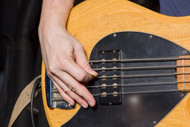Choosing Between a 5 and 6-String Bass
Feb 23rd 2024
Choosing Between a 5- and 6-String Bass
Although the four-string bass guitar is the most popular model, plenty of bassists have decided that four strings aren’t enough — just like some guitarists eventually decide six strings aren’t enough. An extended-range bass lets you play more songs and more types of music while adding a unique sonic quality — all without constantly switching instruments.
While you can extend the range of a bass guitar by using a de-tuning machine or increasing the number of frets, the most common method is to add a string or two. Since being introduced, five-string and six-string basses have gained popularity in everything from metal to country and jazz. But which design is going to be the right extra-big fiddle for you? In this comparison guide, we look at the facts to help you decide whether to choose a five-string bass.

What is a Five-String Bass?
A modern five-string bass takes the standard four-string instrument and adds an ultra-low B-string below the E-string. The first five-string electric bass is believed to be the Fender Bass V that rolled out in 1965 — ironically coming nine years after the first six-string bass. However, these early five-strings added a high-C string rather than a low-B string, and had 15 frets instead of the standard 20. The current five-string bass came about in 1976 when famed luthier Carl Thompson and music company Alembic separately perfected designs. You can still get five-string basses with the high-C string, but these are rare.
Today, almost every major bass manufacturer has at least one five-string bass in their collection. Most notable bass string makers also make five-string bass strings, including D’Addario, DR, Rotosound and Elixir. Some famous five-string bass players are John Paul Jones of Led Zeppelin, Tony Levin of King Crimson, Mike Gordon of Phish and Robert Smith of The Cure.

What is a Six-String Bass?
The contemporary six-string bass adds the ultra-low B-string plus a high-C string, giving you more range above and below the standard four-string. This design differs from the first six-string bass made by Danelectro in 1956, which was tuned one octave down from an electric guitar (E-A-D-G-B-E). Bass maestro Anthony Jackson came up with the idea for the present-day tuning, which he dubbed a contrabass guitar. Carl Thompson — the same Carl Thompson we mentioned earlier — designed the prototype in 1975 while Ken Smith is credited with later perfecting the instrument.
Plenty of instrument makers offer contrabass guitars, with Fodera Guitars, Ibanez and Schecter among the most notable manufacturers. Besides Jackson, other six-string devotees include Phil Lesh, Jimmy Haslip, Tye Zamora and Steve Bailey.
Now that you know a little more about these bass guitars, let’s examine how each impacts the way you play.

Pros of a Five-String Bass
- They let you play lower notes without needing to detune or drop tune. This gives you more options while maintaining string tension for a fuller sound.
- You can get to lower notes when you’re higher on the neck, meaning less movement to play songs with more dynamic ranges.
- While the neck is a little wider than a four-string bass, it still feels and plays similarly, so most players can use it with little or no adjustment period.
- If you aren’t playing the low B-string at a given moment, you can place your thumb on it as an anchor for fast riffs and fills.
- The strings are often a bit closer together, which lets you cross between them with less effort.
Cons of a Five-String Bass
- The closer spacing of the strings also requires you to be a bit more precise, increasing the chances of extra string noise.
- You don’t gain any notes on the high end, so if you want to play chords or do soloing, a five-string won’t help much.
- Five-string bass guitars are heavier than four-strings and require more maintenance.

Pros of a Six-String Bass
- The high-C string increases the treble and lets you play chords with a cleaner, more defined sound, which is useful for doubling or bands without a rhythm guitarist.
- Having a higher note range gives you more possibilities when soloing, making six-string basses popular for jazz music.
- You also get the same added low notes as the five-string, meaning a maximum dynamic range for genres such as metal and progressive rock.
- You have access to even more notes from the same hand position, letting you play complex music with relatively little up-and-down movement.
Cons of a Six-String Bass
- The issues with the five-string concerning neck width and weight are magnified. A contrabass guitar can be very difficult to play if you have smaller hands or a bad back.
- The strings are spaced even closer than a five-string, which is great for chords but can be a challenge for slapping and other techniques.
- Since they aren’t as common, it may be harder to find a bass you like. The selection of six-string bass strings will be more limited, too.
- Between the relative scarcity and the extra materials/manufacturing required, six-string bass guitars and strings are much more expensive.
Final Thoughts
The biggest thing to remember is that five-string and six-string basses are aimed at two distinct types of bassists. The five-string is for someone who likes their four-string but wants some more low-end range and doesn’t want to jump around the neck as much. The six-string bass is almost a different instrument, letting you easily play chords and solos — if your hands are large enough to handle it.
Whichever bass you choose, you can find the right bass guitar strings at Strings and Beyond. The search filters make it easy to find strings for a five-string bass, a contrabass or another extended-range bass.

